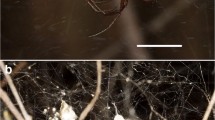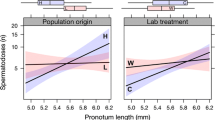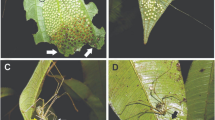Abstract
Female ornamentation may be directly sexually selected, by male choice or female competition, or occurs as the result of a genetic correlation, arising from sexual selection on males. However, increasing evidence supports the former hypothesis, suggesting that males actively choose their partner preferring traits indicative of female quality. In the lagoon goby, Knipowitschia panizzae, a polygynous species whose males perform parental care to eggs, body length and the size of a sex-specific yellow patch on the belly are known to be reliable indicators of female fecundity. In this paper, we tested, using dummies, the male’s mating preferences for female body and yellow belly patch sizes. The two experimental trials in which a single female trait was variable showed that males prefer a larger belly patch and a larger body size, indicating that both these characters are selected by male mate choice. However, when faced with dummies exhibiting an inverse combination of body and belly patch sizes (experiment 3), males significantly preferred the smaller ones with larger yellow belly patches. A calculation of dummy theoretical fecundity reveals that in the first two experiments, males would have received an immediate benefit from their choice in terms of egg number, whereas in the third one, males chose partners that would have provided them with fewer eggs. The male lagoon goby preference for females with larger belly patches, regardless of their size, suggests that this trait, in addition to indicating fecundity, conveys information about other aspects of female and/or egg quality.




Similar content being viewed by others
References
Amundsen T (2000) Why are female birds ornamented? Trends Ecol Evol 15:149–155
Amundsen T, Forsgren E (2001) Male mate choice selects for female coloration in a fish. Proc Natl Acad Sci USA 98:13155–13160
Amundsen T, Forsgren E, Hansen LTT (1997) On the function of female ornaments: male bluethroats prefer colourful females. Proc R Soc Lond B Biol Sci 264:1579–1586
Andersson M (1994) Sexual selection. Princeton University Press, Princeton, NJ
Bagenal TB (1966) A short review on fish fecundity. In: Gerking SD (ed) The biological basis of freshwater fish production. Blackwell, Oxford, UK, pp 89–11
Barlow GW (2005) How do we decide that a species is sex role reversed? Q Rev Biol 80:28–35
Beeching SC, Gross SH, Bretz HS, Hariatis E (1998) Sexual dichromatism in convict cichlids: the ethological significance of female ventral coloration. Anim Behav 56:1021–1026
Berglund A (2000) Sex role reversal in a pipefish: female ornaments as amplifying handicaps. Ann Zool Fenn 36:1–13
Berglund A, Rosenqvist G, Svensson I (1986) Mate choice, fecundity and sexual dimorphism in two pipefish species (Syngnathidae). Behav Ecol Sociobiol 19:301–307
Blount JD (2004) Carotenoids and life-history evolution in animals. Arch Biochem Biophys 430:10–15
Blount JD, Houston DC, Møller AP (2000) Why egg yolk is yellow. Trends Ecol Evol 15:47–49
Bonduriansky R (2001) The evolution of male mate choice in insects: a synthesis of ideas and evidence. Biol Rev 76:305–339
Brooks S, Tyler CR, Sumpter JP (1997) Egg quality in fish: what makes a good egg? Rev Fish Biol Fisher 7:387–416
Chew BP (1996) Importance of antioxidant vitamins in immunity and health in animals. Anim Feed Sci Technol 59:103–114
Clutton-Brock TH, Parker GA (1992) Potential reproductive rates and the operation of sexual selection. Q Rev Biol 67:437–456
Clutton-Brock TH, Vincent ACJ (1991) Sexual selection and the potential reproductive rates of males and females. Nature 351:58–60
Cordoba-Aguilar A, Salamanca-Ocana JC, Lopezaraiza M (2003) Female reproductive decisions and parasite burden in a calopterygid damselfly (Insecta: Odonata). Anim Behav 66:81–87
Cornwallis CK, Birkhead TR (2007) Experimental evidence that female ornamentation increases the acquisition of sperm and signals fecundity. Proc R Soc Lond B Biol Sci 274:583–590
Côte IM, Hunte W (1989) Male and female mate choice in the redlip blenny: why bigger is better. Anim Behav 38:78–88
Darwin C (1871) The descent of man, and selection in relation to sex. Murray, London, UK
Domb LG, Pagel M (2001) Sexual swellings advertise female quality in wild baboons. Nature 410:204–206
Dosen L, Montgomery R (2004) Female size influences mate preferences of male guppies. Ethology 110:245–255
Edge R, McGarvey DJ, Truscott TG (1997) The carotenoids as anti-oxidants—a review. J Photochem Photobiol B 41:189–200
Emlen ST, Oring LW (1977) Ecology, sexual selection, and the evolution of mating systems. Science 197:215–223
Fitzpatrick S (1994) Colourful migratory birds: evidence for a mechanism other than parasite resistance for the maintenance of ‘good genes’ sexual selection. Proc R Soc Lond B Biol Sci 257:155–160
Gabor CR (1999) Association patterns of sailfin mollies (Poecilia latipinna): alternative hypotheses. Behav Ecol Sociobiol 46:333–340
Gandolfi G, Zerunian S, Torricelli P, Marconato A (1991) I Pesci delle acque interne italiane. Istituto Poligrafico e Zecca dello Stato, Roma, Italy
Gray DA (1996) Carotenoids and sexual dichromatism in North American passerine birds. Am Nat 148:453–480
Griggio M, Valera F, Casas A, Pilastro A (2005) Males prefer ornamented females: a field experiment of male choice in the rock sparrow. Anim Behav 69:1243–1250
Griggio M, Serra L, Licheri D, Monti A, Pilastro A (2007) Armaments and ornaments in the rock sparrow: a possible dual utility of a carotenoid-based feather signal. Behav Ecol Sociobiol 61:423–433
Hamilton WD, Zuk M (1982) Heritable true fitness and bright birds: a role for parasites? Science 218:384–387
Hanssen SA, Folstad I, Erikstad KE (2006) White plumage reflects individual quality in female eiders. Anim Behav 71:337–343
Heinsohn R, Legge S, Endler J (2005) Extreme reversed sexual dichromatism in a bird without sex role reversal. Science 309:617–619
Hill GE (1991) Plumage coloration is a sexually selected indicator of male quality. Nature 350:337–339
Itzkowitz M, Draud MJ, Barnes JL, Haley M (1998) Does it matter that male beaugregory damselfish have a mate preference? Behav Ecol Sociobiol 42:149–155
Jawor JM, Gray N, Beall SM, Breitwisch R (2004) Multiple ornaments correlate with aspects of condition and behaviour in female northern cardinals, Cardinalis cardinalis. Anim Behav 67:875–882
Johnsen TS, Hengeveld JD, Blank JL, Yasukawa K, Nolan V Jr (1996) Epaulet brightness and condition in female red-winged blackbirds. Auk 113:356–362
Johnstone RA, Reynolds JD, Deutsch J (1996) Mutual mate choice and sex differences in choosiness. Evolution 50:1382–1391
Kodric-Brown A (1989) Dietary carotenoids and male mating success in the guppy: an environmental component to female choice. Behav Ecol Sociobiol 25:393–401
Kokko H, Monaghan P (2001) Predicting the direction of sexual selection. Ecol Lett 4:159–165
Kraak SM, Bakker TCM (1998) Mutual mate choice in sticklebacks: attractive males choose big females, which lay big eggs. Anim Behav 56:859–866
Kvarnemo C, Forsgren E (2000) The influence of potential reproductive rate and variation in mate quality on male and female choosiness in the sand goby, Pomatoschistus minutus. Behav Ecol Sociobiol 48:378–384
Kvarnemo C, Simmons LW (1999) Variance in female quality, operational sex ratio and male mate choice in a bushcricket. Behav Ecol Sociobiol 45:245–252
Lande R (1980) Sexual dimorphism, sexual selection, and adaptation in polygenic characters. Evolution 34:292–305
LeBas NR, Marshall NJ (2000) The role of colour in signalling and male choice in the agamid lizard Ctenophorus ornatus. Proc R Soc Lond B Biol Sci 267:445–452
LeBas NR, Hockham LR, Rotchie MG (2003) Nonlinear and correlational sexual selection on ‘honest’ female ornamentation. Proc R Soc Lond B Biol Sci 270:2159–2165
Lozano GA (1994) Carotenoids, parasites, and sexual selection. Oikos 70:309–311
MacLaren RD, Rowland W, Morgan N (2004) Female preferences for sailfin and body size in the sailfin molly, Poecilia latipinna. Ethology 110:363–379
Massironi M, Rasotto MB, Mazzoldi C (2005) A reliable indicator of female fecundity: the case of the yellow belly in Knipowitschia panizzae (Teleostei: Gobiidae). Mar Biol 147:71–76
McGraw KJ, Adkin-Regan E, Parker RS (2005) Maternally derived carotenoid pigments affect offspring survival, sex ratio, and sexual attractiveness in a colourful songbird. Naturwissenschaften 92:375–380
Nordeide JT (2002) Do male sticklebacks prefer females with red ornamentation? Can J Zool 80:1344–1349
Nordeide JT, Rudolfsen G, Egeland ES (2006) Ornaments or offspring? Female sticklebacks (Gasterosteus aculeatus L.) trade off carotenoids between spines and eggs. J Evol Biol 19:431–439
Olson VA, Owens IPF (1998) Costly sexual signals: are carotenoids rare, risky or required? Trends Ecol Evol 13:510–514
Pélabon C, Borg ÅA, Bjelvenmark J, Forsgren E, Barber I, Amundsen T (2003) Do male two-spotted gobies prefer large fecund females? Behav Ecol 14:787–792
Pizzari T, Cornwallis CK, Lovlie H, Jakobsson S, Birkhead TR (2003) Sophisticated sperm allocation in male fowl. Nature 426:70–74
Potti J, Merino S (1996) Decreased levels of blood trypanosome infection correlate with female expression of a male secondary sexual trait: implications for sexual selection. Proc R Soc Lond B Biol Sci 263:1199–1204
Ptacek MB, Travis J (1997) Mate choice in the sailfin molly, Poecilia latipinna. Evolution 51:1217–1231
Rennie S, Huntingford FA, Loeland A-L, Rimbach M (2005) Long term partial replacement of dietary fish oil with rapeseed oil; effects on egg quality of Atlantic salmon Salmo salar. Aquaculture 248:135–14
Roulin A, Riols C, Dijkstra C, Ducrest A-L (2001) Female plumage spottiness signals parasite resistance in the barn owl (Tyto alba). Behav Ecol 12:103–110
Sargent RC, Gross MR, Van den Berghe EP (1986) Male mate choice in fishes. Anim Behav 34:545–550
Simmons LW, Kvarnemo C (2006) Costs of breeding and their effects on the direction of sexual selection. Proc R Soc Lond B Biol Sci 273:465–470
Svensson PA, Pélabon C, Blount JD, Surai PF, Amundsen T (2006) Does female nuptial coloration reflect egg carotenoids and clutch quality in the two-spotted goby (Gobiusculus favescens, Gobiidae)? Funct Ecol 20:689–698
Torres R, Velando A (2005) Male preference for female foot colour in the socially monogamous blue-footed booby, Sula nebouxii. Anim Behav 69:59–65
Vincent A, Ahnesjö I, Berglund A, Rosenqvist G (1992) Pipefishes and seahorses: are they all sex role reversed? Trends Ecol Evol 7:237–241
von Schantz T, Bensch S, Grahan M, Hasselquist D, Wittsell H (1999) Good genes, oxidative stress and condition-dependent sexual signals. Proc R Soc Lond B Biol Sci 266:1–12
Wedekind C, Meyer P, Frischknecht M, Niggli UA, Pfander H (1998) Different carotenoids and potential information content of red coloration of male three-spined stickleback. J Chem Ecol 24:787–801
Whitehead PJP, Bauchot M-L, Hureau J-C, Nielsen J, Tortonese R (1986) Fishes of the north-eastern Atlantic and the Mediterranean. UNESCO, Paris, France
Wolf WL, Casto JM, Nolan V, Ketterson ED (2004) Female ornamentation and male mate choice in dark-eyed juncos. Anim Behav 67:93–102
Acknowledgments
This research was performed at the Hydrobiological Station of Chioggia (University of Padova), whose staff we thank. We wish to thank A. Pilastro for help with the experimental design, C. Petersen and C. Romualdi for statistical advice and two anonymous referees for the review of the manuscript. The work was financially supported by Ministero Italiano dell’Università e della Ricerca Scientifica grants. All experiments were conducted in accordance with Italian laws on the treatment of animals.
Author information
Authors and Affiliations
Corresponding author
Additional information
Communicated by C. Gabor
Rights and permissions
About this article
Cite this article
Pizzolon, M., Rasotto, M.B. & Mazzoldi, C. Male lagoon gobies, Knipowitschia panizzae, prefer more ornamented to larger females. Behav Ecol Sociobiol 62, 521–528 (2008). https://doi.org/10.1007/s00265-007-0476-1
Received:
Revised:
Accepted:
Published:
Issue Date:
DOI: https://doi.org/10.1007/s00265-007-0476-1




